
[Varian Fry Institute Home] [Chambon Foundation Home]

A Year That Mattered
Varian Fry and the Refugee Crisis, Marseille 1940-41
the true story of the most
successful private American-led
rescue effort during the Nazi era
a long-upcoming
feature documentary by Pierre Sauvage
a Varian Fry Institute / Chambon
Foundation production
Judging from the footage he has completed so far, Sauvage
has another inspiring effort on his hands.
George Robinson, The
Jewish Week

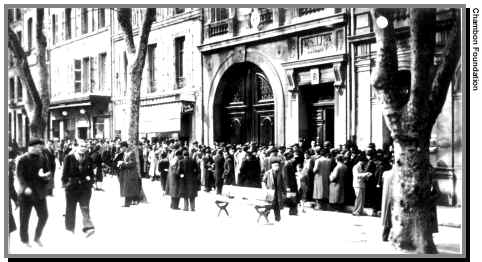
New York Post, 1941; Varian Fry (photo by Hans Namuth); U.S. Consulate, Marseille, France, 1940 (photo by Dr. Hans Cahnmann)
Varian Varian Fry (1907-1967) was a New York intellectual who after the fall of France to the Nazis spent a year in the Southern port city of Marseille leading one of the most remarkable and successful rescue efforts of the Nazi era. Defying the Nazis, the French Vichy regime, and his own government, Fry, a dapper, 32 year-old intellectual, led a unique mission that helped to save some 2,000 artists, intellectuals, and anti-Nazi refugees, Jewish and non-Jewish. He was the first American to be singled out by Israel's Holocaust memorial Yad Vashem as a Righteous Among the Nations—a righteous gentile.
An extended overview of the Fry mission and why it matters is available at Varian Fry in Marseille. As the feature documentary will underscore, Varian Fry did not work alone. A Year That Matters (formerly And Crown Thy Good) is a production of the Varian Fry Institute, a division of the Chambon Foundation, a nonprofit foundation committed to documentary exploration of the Holocaust—and especially of those necessary and challenging lessons of hope intertwined with the unavoidable lessons of despair.
Throughout the '30s, many of Hitler’s most prominent or determined opponents—among them non-Jewish artists, intellectuals, political figures—had found refuge in Paris. When France too fell to the Nazis, many of these exiles fled south. As the collaborationist Vichy regime turned on the Jews and the refugees, Marseille, the bustling, colorful port on the Mediterranean, became the real Casablanca.

Berlin, 1935, photo by Varian Fry
(USHMM)
In New York, where he had been a foreign policy analyst, Fry had been among a small group of Americans who had realized that when a defeated France had signed the armistice with Nazi Germany, it had agreed to “surrender on demand” refugees to the Nazis.
A few (non-Jewish) Americans too found their way to Marseille in the summer of 1940: an ornery New York intellectual named Varian Fry; Mary Jayne Gold, a beautiful heiress who soon took on a gangster lover; Miriam Davenport, a scholarly female art student; Charles Fawcett, an adventurer from South Carolina always on the look-out for a good cause, the ever-helpful Leon Ball, whose own account of these events will be revealed for the first time... Fry was also assisted by a rare righteous U. S. consul: Hiram Bingham IV.
|
|
|
Mary Jayne Gold and Miriam
Davenport Ebel |
in Ambulance Corps uniform |
Charles
Fawcett in Marseille |
Under Fry’s leadership, banding together with others—early French opponents to Vichy, Jewish and non-Jewish refugees from the Third Reich—this tiny group set out to save a culture. Ultimately, Fry’s mission helped save some 2,000 people. Among them were such major figures as Marc Chagall, Max Ernst, Jacques Lipchitz, Hannah Arendt, Heinrich Mann, Franz Werfel, Alma Mahler Werfel…
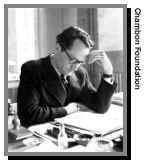
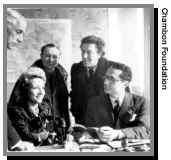
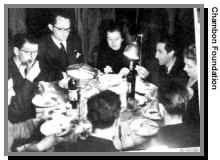
Varian
Fry at office; artists Max Ernst, Jacqueline Breton, André Masson,
poet and artist André
Breton visit Varian Fry in his office; Varian Fry with staff
How the European refugees contributed to America and influenced its culture has already been chronicled in books and documentaries. However, there has been no comprehensive American documentary on the rescue effort itself. This documentary fills this gap while there were still witnesses to tell the story.
The rescue mission is the subject of a "highly fictionalized" limited series on Netflix, Transatlantic. The Fry mission is also briefly mentioned in the 2022 PBS documentary series The U.S. and the Holocaust.
What makes the saga especially useful is that is provides a rare illustration of the intellectual as activist hero. Varian Fry loved the arts so much that he did all that he possibly could to save their creators. Few intellectuals have wandered further from the ivory towers. Though ostensibly unprepared and unsuited for the stressful and dangerous undercover work he embarked upon, Varian Fry, as the rescue effort grew in scope, became a still little-known American hero. A gifted writer, he has, moreover, left an eloquent paper trail of his moral and physical exploits.
The Chambon Foundation's Varian Fry Institute—which focuses on exploring the American experience of the Holocaust—is a major depository of Fry-related materials, including Fry’s original negatives from that time and the collections of key Fry aides Miriam Davenport Ebel and Mary Jayne Gold, as well as materials from the Annette Riley Fry collection.
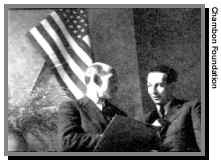
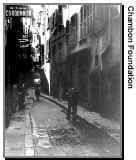
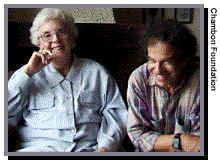
Marseille photos by Varian Fry, 1940-41;
the
late Mary Jayne Gold with friend and filmmaker Pierre Sauvage,
during production of A Year That Mattered
Documentary filmmaker Pierre Sauvage comes to the project with extensive preparation and a long friendship with many of the principals, most of whom are now deceased. His parents, Jewish intellectuals, were among those who fled from Paris to Marseille and sought Fry’s help—unsuccessfully. Later in the Occupation, the filmmaker’s family was among the 5,000 Jews sheltered by a small mountain community in France, the area of Le Chambon-sur-Lignon, as he recounted in the highly acclaimed feature documentary Weapons of the Spirit, to be re-released in a newly remastered 2023 edition.
Also being released in 2023 is Sauvage's challenging documentary Not Idly By—Peter Bergson, America and the Holocaust, which deals with the American reaction—and the American Jewish reaction—to the Holocaust, providing testimony about one remarkable Jewish response to the mass murders.
A Year That Mattered will be about one righteous American response to the growing crisis in Europe in 1940-41. Like all such stories of rescue, it will underscore what it was possible to know and do.
The Holocaust did not just happen there—the Holocaust happened wherever it was allowed to happen. In that sense, to a still unrecognized degree, the Holocaust happened in the United States too. Until mid-1941, Nazi policy towards the Jews had been one of persecution, theft, expulsion. But the main problem then wasn’t getting out—it was getting in. Varian Fry’s story illustrates and underscores the crucial decisions faced by American officials—and Americans at large—at that time. It was a year that mattered for all of us.
 |
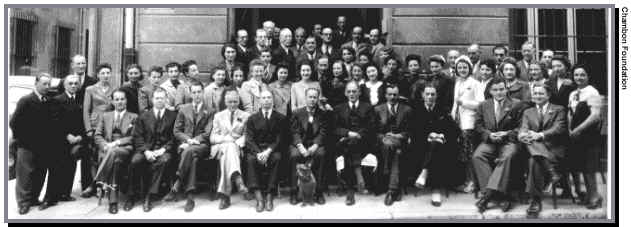 |
| Refugees at U. S. Consulate in Marseille in 1940 | U. S. Consulate staff, Marseille, 1941 |
When Fry posthumously became the first American honored by Israel’s Holocaust Memorial Yad Vashem as a righteous Gentile, former Secretary of State Warren Christopher paid tribute to him by acknowledging the failings of the Department of State at that important juncture in history. The story of this rescue effort will help viewers approach the still sensitive issue of America’s response to the refugee crisis—and to what was to become the Holocaust. Against this somber backdrop, Fry’s American colleagues in Marseille—all from families with American roots that go back centuries—will stand out as stirring exemplars of American values in action.
Above all, A Year That Mattered will explore the choices faced by all the protagonists of the story: Varian Fry, his colleagues, the local American officials, the U. S. government, the refugees.
What did Americans know? What could they have reasonably been expected to do? What is the extent of one’s obligations towards others? Can Fry’s mission be fairly described as elitist? Or given that it is seldom possible to save everyone who needs saving, is it legitimate to begin with those whom one loves? What should be the role of the intellectual in such a situation? What are the obligations to society of the artist in a time of crisis? How did the refugees respond to the crisis? How did their level of culture and sophistication affect the ability to cope?
These are among the questions that we aim to raise—while above all telling a singular story.
With ever-growing American interest in the those times, telling a dramatic and exciting story about American heroes, set in a very colorful city and a very beautiful area of the world, And Crown Thy Good should both attract and hold a wide audience, while exploring important and timeless issues. Glenn Marcus, then Associate Director, P.B.S. National Program Service, wrote to the filmmaker that this documentary “is as close to a sure thing as we can imagine—an outstanding topic that has awaited its definitive treatment for the American audience, and the Emmy Award winning filmmaker perfectly suited to that task.”
Ideologically, the feature documentary’s approach will be similar to the one taken on the filmmaker’s earlier Weapons of the Spirit—but visually it will not. Weapons of the Spirit required relentless simplicity of form. And Crown Thy Good will aim to be visually inventive, seeking to draw inspiration from some of the creative 20th century giants being evoked, while drawing on state-of-the-art digital possibilities and creativity.
And Crown Thy Good also will not have a personal tone. Indeed, major stars will be enlisted to deliver the narration and do dramatic readings of source materials quoted in the documentary, further enhancing its potential with audiences.
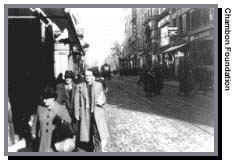
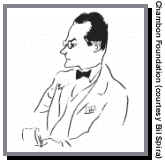
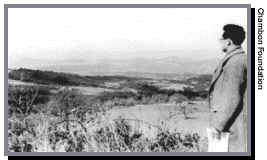
Varian Fry in Marseille in 1940-41; caricature of Varian Fry in Marseille in
1940 by Bil Spira;
Varian Fry in Provence in 1940-41
Public attention on Varian Fry keeps growing, initially spurred by the United States Holocaust Memorial Museum’s pioneering opening exhibit on the rescue effort, which traveled to New York and Chicago. (The Chambon Foundation provided many of the photographs for the exhibit, with filmmaker Pierre Sauvage serving as a consultant). In the future, the Varian Fry Institute may sponsor its own traveling exhibit, in conjunction with the opening of the documentary.
Several commercial Hollywood projects pertaining to Varian Fry have been in development (one bad cable TV movie was made), and a limited series related to the mission is scheduled for Netflix in 2023. Perhaps America’s Raoul Wallenberg will be turned into the household name he deserves to be. This will both heighten interest in the subject and create a pressing need for a documentary—and documented—account of the story and its meaning.
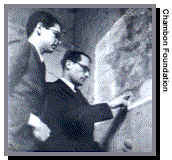

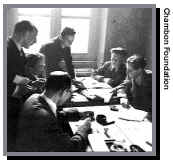
Varian Fry’s Centre américain de
secours (American Relief Center)
And Crown Thy Good will follow Weapons of the Spirit on the film festival circuit and into theaters. Weapons of the Spirit, a subtitled documentary dealing exclusively with France, opened in fifty markets throughout the U.S., running seven weeks in New York, Los Angeles, Boston, Washington... With its American heroes and American focus, And Crown Thy Good should be able to do at least as well.
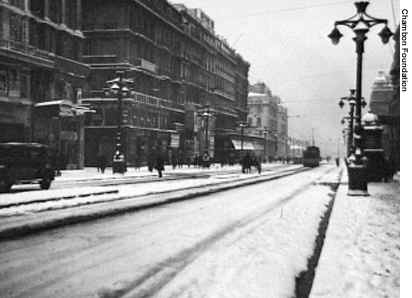
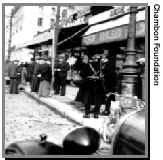
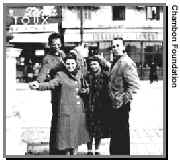
Left: Marseille in 1941; center:
raid at the café that was the intellectuals’
hang-out (photo by Hiram Bingham IV);
right: refugees, including artist Wifredo Lam (left) in Marseille in 1940
(photo by André Gomès)
When Weapons of the Spirit was broadcast on PBS (three national prime-time runs), it was introduced by Bill Moyers and followed by a half-hour interview of the filmmaker by Moyers. And Crown Thy Good should lead to similar round-table discussions on the issue of America’s response to the wartime refugee crisis in Europe.
A study guide will be produced for And Crown Thy Good, with the intention of similarly fostering educational use of the documentary. There will also be free distribution of relevant materials on the Varian Fry Institute’s website—including streaming video excerpts from the documentary—making the most of the hugely growing opportunities that the Internet provides for promoting and disseminating such documentaries.
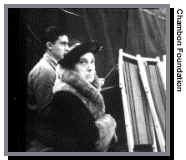
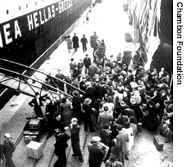
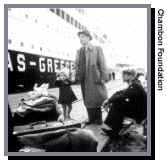
Lisbon,
1941; the Nea Hellas sails from
Lisbon for America
The documentary draws on:
· Location shooting in the U.S., France, Spain, Germany, Italy, Switzerland;
· Interview footage culled from over 200 interviews;
· Stills from the Varian Fry Institute's extensive Fry-related photographic archives—the largest in the world—which include Varian Fry's several hundred original negatives from that time;
· Newsreel footage;
· Home movies (including footage never seen before);
· Contemporary footage of relevant locations;
· Varian Fry papers and other relevant documents;
· Star narrators.
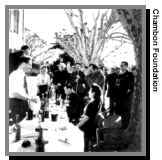
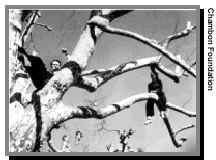
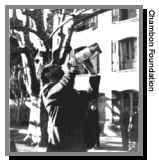
Varian
Fry at Air
Bel: during auction; in tree with Consuelo de St. Exupéry; imbibing
Key locations include:
· The rescue operation’s successive offices in Marseille at the former Hotel Splendide, on rue Grignan, and on Boulevard Garibaldi (with Emergency Rescue Committee staffers Miriam Davenport Ebel, since deceased, and Charles Fawcett returning to Marseille to serve as tour guides);
· the chateau that served as the remote headquarters for the visa section of the American consulate in Marseille in 1940-41;
· the goat and smugglers’ trail through the Pyrenees to Spain used by many fleeing refugees;
· the location of the legendary Air-Bel, also known as the "chateau," where many artists, especially Surrealists, congregated with Fry and his co-workers:
· the magnificent central old harbor of Marseille, from which one could gaze at freedom;
· the picturesque medieval villages of touristy Les Baux and untouristy Revest-des-Broust, where Varian Fry hid some of his wards;
· the remote village of Gordes, where Chagall lived;
· the brick factory and former internment camp of Les Milles (with unrestricted access provided for the first time, allowing filming in areas where artists like Max Ernst and other refugees lived and slept);
· the former internment camps of Gurs, Le Vernet and Rivesaltes;
· Mary Jayne Gold’s villa “Air Bel” in Gassin/Saint Tropez, France;
· the Maillol Museum in Paris;
· the exhibit on the French internment camps at the Holocaust Center in Paris;
· the Los Angeles Museum of Art's exhibit "Exiles and Emigrés: the Flight of European Artists From Hitler," which focused on a number of artists helped by Varian Fry (the Chambon Foundation provided protographic materialls from its archives);
· the “Assignment: Rescue” exhibit at Jewish Museum, New York City;
· the French historical exhibit and conference on Varian Fry in Marseille (of which the Chambon Foundation was a co-sponsor);
· the French art exhibit on refugee artists of that time;
· various New York City locations;
The The filmmaker has drawn on the expertise of the major scholars in the field. Until their deaths, Dr. Miriam Davenport Ebel, an art scholar and close associate of Varian Fry’s in Marseille, and Dr. David S. Wyman, the leading American scholar on the American response to the Holocaust, served as key consultants on the documentary. Dr. Michael R. Marrus, one of the leading scholars on the Holocaust (recently deceased), Dr. Robert O. Paxton, the leading American scholar on Vichy France, and Dr. Christopher Browning serve or have served as historical consultants.
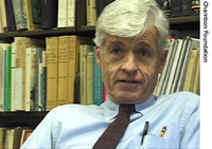 |
||
|
Dr. Robert O. Paxton during production of And Crown Thy Good |
The The Chambon Foundation Boards have long included numerous scholars, who have been called upon to participate in or advise on the project. Our Board of Directors includes: Dr. Michael R. Marrus (recently deceased), professor at the University of Toronto and a prominent Holocaust scholar and the co-author with Dr. Robert O. Paxton of the ground-breaking Vichy France and the Jews and Dr. John K. Roth, Christian scholar of both the Holocaust and religion, and the author of many books. The late Dr. Harold M. Schulweis, prominent rabbi, author, and founder of Jewish World Watch, was a founding member of the board.
Our Board of Advisers includes or has included: historians Dr. Omer Bartov, Dr. Yehuda Bauer, Dr. Henry L. Feingold, Dr. Nechama Tec; scholars Dr. Irving Greenberg, Dr. Robert Jay Lifton, Dr. Samuel P. Oliner, Dr. Robert O. Paxton and Dr. David S. Wyman, legendary journalist and activist Ruth Gruber, scholar Samantha Power, author and radio personality Dennis Prager, author and Nobel Peace Prize-winner Elie Wiesel.
The
Varian Fry Institute is a division of the Chambon Foundation, a 501(c)3 public charitable educational foundation.
Contributions to the Varian Fry Institute are tax-deductible—and will be greatly appreciated!
[Varian Fry Institute Home] [Chambon Foundation Home]
[email us] [contact information] [table of contents] [search] [feedback] [guest book] [link to us?]
© Copyright 2023. Varian Fry Institute. All rights reserved. Revised: April 5, 2023